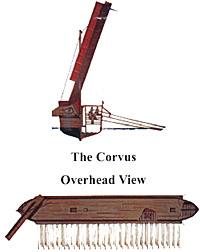The Roman Enigma:
The First Punic War
by Philip J. Viverito
| |
Rome in the First Punic War is something of an enigma. The Republic was well suited to the boot like Italian peninsula. I often think of the Roman Republic like a foot neatly nestled into a fine Italian boot; warm and isolated from the greater outside world of the Mediterranean. So insulated on the Italian peninsula Rome occupied herself with dominating the land locked Latin world. How different initially Rome was from the robustly entrepreneurial and cosmopolitan City of Carthage. At this time few enemies of Rome had the skill to beat her on land. Being insulated and rather unsophisticated in worldly ways Rome was able to look at problems with practically and imagination. By its very nature naval warfare of the period required vessels to close with enemy vessels so as to ram or sheer off enemy oars. Both tactics required great seaman ship. The Romans were land lubbers and the Carthaginians knew no fear at sea. Once set to a challenge Rome would not rest and would over come her initial isolationist and narrow nature. To every problem there was a Roman answer. At first Rome relied on Magna Graecia for its ships. Capturing a Carthaginian warship gave the Romans an engineering challenge. The Graecian cities of Southern Italy might have had the ability to build warships for the Romans but the Romans had the engineering skills that could take Graecian designs and blend them with Carthaginan refinements. The Carthaginians did not realize that the Roman vessels now had a new refinement; a way to reach out and hold fast the better crewed Punic vessels. The problem of how to chal lenge Carthage at sea did not strain the Roman ability to solve the problem_ The Romans knew that most Carthaginain sea captains could sail rings round any Roman fleet. The Romans recognized that they must fight the Carthaginians at sea. Thinking out of the box the Romans managed to bring their expertise in land warfare to sea. To do this the Roman engineers fixed a stout spiked gang plank called a corvus or crow on their ships. The corvus were mounted in such a way that they could swing in a number of directions. Once close enough the Romans dropped the corvus onto the enemy deck; locking the vessels together. The Roman ships became fighting platforms; skillfully managing to make naval warfare like land warfare. The Roman vessels were like cats with claws. Knowing that the Carthaginians held them in contempt at sea the Carthaginians would not hesitate to come to grips with Roman ships. Hannibal however, was yet to be released on an unsuspecting Rome. Back to Table of Contents -- Classical Hack Newsletter # 5 Back to Classical Hack Newsletter List of Issues Back to MagWeb Master Magazine List © Copyright 2004 by Phil Viverito. This article appears in MagWeb.com (Magazine Web) on the Internet World Wide Web. Other articles from military history and related magazines are available at http://www.magweb.com |
